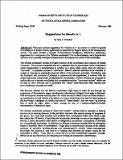| dc.description.abstract | This paper presents suggestions for "Genetic A.I.": an attempt to model the genesis of intelligence in human infants, particularly as described by Piaget's theory of the Sensorimotor period. The paper includes a synopsis of Sensorimotor intelligence, followed by preliminary suggestions for a mechanism (the "Schema mechanism") for its development, and a hypothetical Scenario which partially reinterprets Sensorimotor development in terms of that mechanism.
The Schema mechanism focuses on Piaget's concept of the competition and evolution of mental "schemas." The schema is modelled here as an assertion that one partial state of the mechanism's world-representation is transformable to another via a given action, taken when the schema is "activated". A proposed process of "correlation" allows a schema's assertion to be extended or revised in response to empirically-observed effects of the schema's activation. Correlation uses the the formation and activation of schemas to propose and test hypothesis, in contrast with the passive tabulation characteristic of associationist mechanisms. Further features are proposed to enable schemas to become coordinated into composite structures, "compound actions", which can be used by other schemas; and to synthesize new "items" (state-elements) when existing ones prove inadequate to model the world.
The Scenario outlines how the Schema mechanism might begin to make its way through the progression of Sensorimotor stages; development culminating in Piaget's third stage is discussed. This development includes learning about the visual and tactile effects of eye and hand motions-- eg, learning how to look directly at an object, or to move a hand into view; and the organization of that knowledge to designate the tactile properties of "visual objects", and vice versa-- eg knowing how to touch an object which is seen-- paving the way to a sensory-modality-invariant representation of objects and space.
The Schema mechanism attempts to "learn from scratch", without built-in expertise or built-in structure in its learning domains. In the past there has been little success among AI programs of this genre. But many such attempts have suffered from mechanisms which were trivial in that they placed the full burden of acquiring and structuring knowledge on one or two simple tricks, whereas, I claim, the present effort shows a willingness to incorporate a multiplicity of elements in a complicated mechanism. In addition, the Schema mechanism benefits from its orientation around a nontrivial theory of development. Piaget gives a comprehensive account of the infant's evolution of primitive problem-solving and domain-specific (chiefly object-manipulation) knowledge; this account is used here as a roadmap that describes the proper course for the mechanism to follow. Thus, there is a nontrivial (or at least nonarbitrary) sequence of target abilities to use as a framework for evaluating and revising the mechanism's performance. | en |
